Physical Address
304 North Cardinal St.
Dorchester Center, MA 02124
Endoscopic orbital surgery requires a multidisciplinary approach by an oculoplastic surgeon and an otolaryngologist with proficiency in both rhinologic and orbital surgery.
Chronic epiphora should be investigated with a dacryocystogram, and possibly a scintillogram, prior to surgery, to localize the site of obstruction to ensure that it is amenable to dacryocystorhinostomy (DCR). If these studies are unavailable, expert clinical exam with Jones I and II testing can similarly localize site of obstruction.
Although anatomic obstructions of the lacrimal system are associated with excellent surgical outcomes, functional obstructions have less impressive responses to surgery. It is important to differentiate between these two types of obstruction to determine a patient's prognosis.
The superior edge of the lacrimal sac is located well above the insertion of the middle turbinate. Surgical outcomes are improved when the entire sac is marsupialized.
The primary surgical goal is for the marsupialized lacrimal sac to lay out flat, in direct contact with surrounding mucosa, for primary intention healing. This concept allows outcomes of endonasal DCR to be equal or better than those of external DCR.
Advantages of endonasal DCR over external DCR include lack of an incision and no disruption of the lacrimal pump mechanism.
Indications for orbital decompression in patients with Graves orbitopathy include cosmetic irregularity, exposure keratopathy, and compressive optic neuropathy.
Diplopia is a significant risk of orbital decompression surgery. “Diplopia sparing” techniques include preservation of an inferomedial orbital strut, a medial strip of periorbita, and the concept of balanced decompression.
Preservation of normal sinonasal physiology after orbital decompression surgery is paramount. This is best accomplished by opening the maxillary sinus widely and avoiding dissection of the frontal sinus outflow tract.
The role of optic nerve decompression in patients with traumatic optic neuropathy is controversial. Treatment should ultimately be individualized to the specific patient and clinical scenario.
In contrast, the majority of patients with compressive optic neuropathy derive significant improvement in visual acuity from optic nerve decompression.
Benign extraconal and intraconal orbital tumors medial to the optic nerve are appropriate for an exclusively endonasal approach. Tumors predominantly medial to the optic nerve with some inferolateral extension may still be managed endoscopically but carry increased risk and should be reserved for surgeons with extensive experience with endoscopic orbital tumor surgery.
As surgeons mastered endoscopic techniques to safely dissect the ethmoid and sphenoid sinuses, creative rhinologic mavens started “thinking outside of the [ethmoid] box” and began utilizing the paranasal sinuses as a transit route to access previously inaccessible areas of the skull base. It was rather early in the history of transnasal endoscopic surgery that orbital surgery was first proposed. Early reports of medial wall orbital decompression for Graves disease were spectacular, offering a clear place for this novel approach in the treatment of this disease. Soon, proposed endoscopic transnasal surgical approaches for dacryocystorhinostomy (DCR), optic nerve decompression, and intraorbital pathology would challenge long-established open routes for dominance. The following chapter details the current suite of endoscopic interventions commonly applied to orbital pathology.
The most critical element for the successful management of distal lacrimal system pathology that requires endoscopic DCR is the creation of the widest possible marsupialization of the medial wall of the lacrimal sac. Diagnostic determination of the site of blockage is imperative because lesions proximal to the common canaliculus cannot be managed with DCR alone. The endoscopic surgeon should not attempt this procedure without a highly detailed understanding of the nasal anatomy related to the lacrimal sac, along with appropriate equipment, excellent exposure, and careful attention to mucosa preservation ( ).
DCR is the surgical bypass of the lacrimal sac and duct for the treatment of epiphora, a condition in which tears accumulate to the point that they drain down the face. This is differentiated from a “watery eye,” in which an abnormally thick tear film alters vision but does not drain onto the skin. This distinction is important in that epiphora is most likely caused by obstructions that are treated with surgery, whereas the differential of disorders that may lead to a watery eye is caused by either tear-film composition anomalies or reflex tearing from corneal irritation; these are generally treated medically.
The two principal categories of lacrimal obstruction are anatomic and functional. Anatomic obstructions are complete physical blockages, most commonly noted between the lacrimal sac and nasal cavity, which are predictable based on age. Functional obstructions are caused either by critical narrowings within the lacrimal system that delay normal lacrimal flow or by a failure of the proximal pumping mechanism. Anatomic obstructions are more common than functional obstructions by a ratio of 70% to 30%. Both anatomic and functional obstructions may be managed with endoscopic DCR; however, anatomic obstructions are noted to have superior outcomes. Children with congenital nasolacrimal duct obstruction will often have an imperforate Hasner valve that may be amenable to probing, whereas young adults tend to have pathology of the canaliculi that causes epiphora. Groups amenable to DCR include middle-aged patients, who have a higher incidence of dacryoliths, and elderly patients, who typically have lacrimal duct obstruction.
The greatest challenge to achieving excellent DCR outcomes is the complete extirpation of bone from the medial aspect of the lacrimal sac ( Fig. 49.1A ). The axilla of the middle turbinate makes an excellent endoscopic landmark to locate the lacrimal sac. The upper third of the sac will lie just superior to the anterior insertion of the middle turbinate, and the remaining inferior portion of the sac is oriented vertically, just under the anterior maxillary line or lacrimomaxillary suture. The frontal process of the maxilla and the lacrimal bone are the two bone segments on either side of the lacrimomaxillary suture that need to be removed during endoscopic DCR. Just above the midportion of the lacrimal sac, the frontal process of the maxilla merges medially into the axilla of the middle turbinate, posterior to which is the agger nasi cell. Because the axilla will be significantly reduced during DCR, incorporation of the opened agger nasi cell into the marsupialized lacrimal sac will be required in 55% of cases, although the agger nasi cell will be opened as part of the sac exposure in almost all DCRs. The posterior and inferior bony confine of the medial sac is the lacrimal bone. This very thin bone is easily flaked off and contrasts dramatically with the look and feel of the frontal process of the maxilla. The uncinate attaches posteriorly to the lacrimal bone and is similarly thin, so care must be taken to prevent its inadvertent removal. Once the lacrimal sac is opened, the endoscopic surgeon should find the opening of the common canaliculus (common internal punctum) approximately 3 mm above where the base of the axilla had been located. A ball probe can then be run superiorly along the lateral surface of the opened sac to locate any remaining bone that may impede complete sac marsupialization. Identification of the common internal punctum is a critical landmark, because it represents the most proximal portion of the lacrimal system that can be successfully managed by DCR and, when positioned in the center of the opened sac, it allows the surgeon to know that the procedure has been performed correctly. Stenosis of the superior, inferior, and common canaliculi cannot be successfully managed with DCR alone (see Fig. 49.1B ). The most distal portion of the lacrimal system is the lacrimal duct, which extends from the inferior-most portion of the sac and opens into the inferior meatus via the Hasner valve.
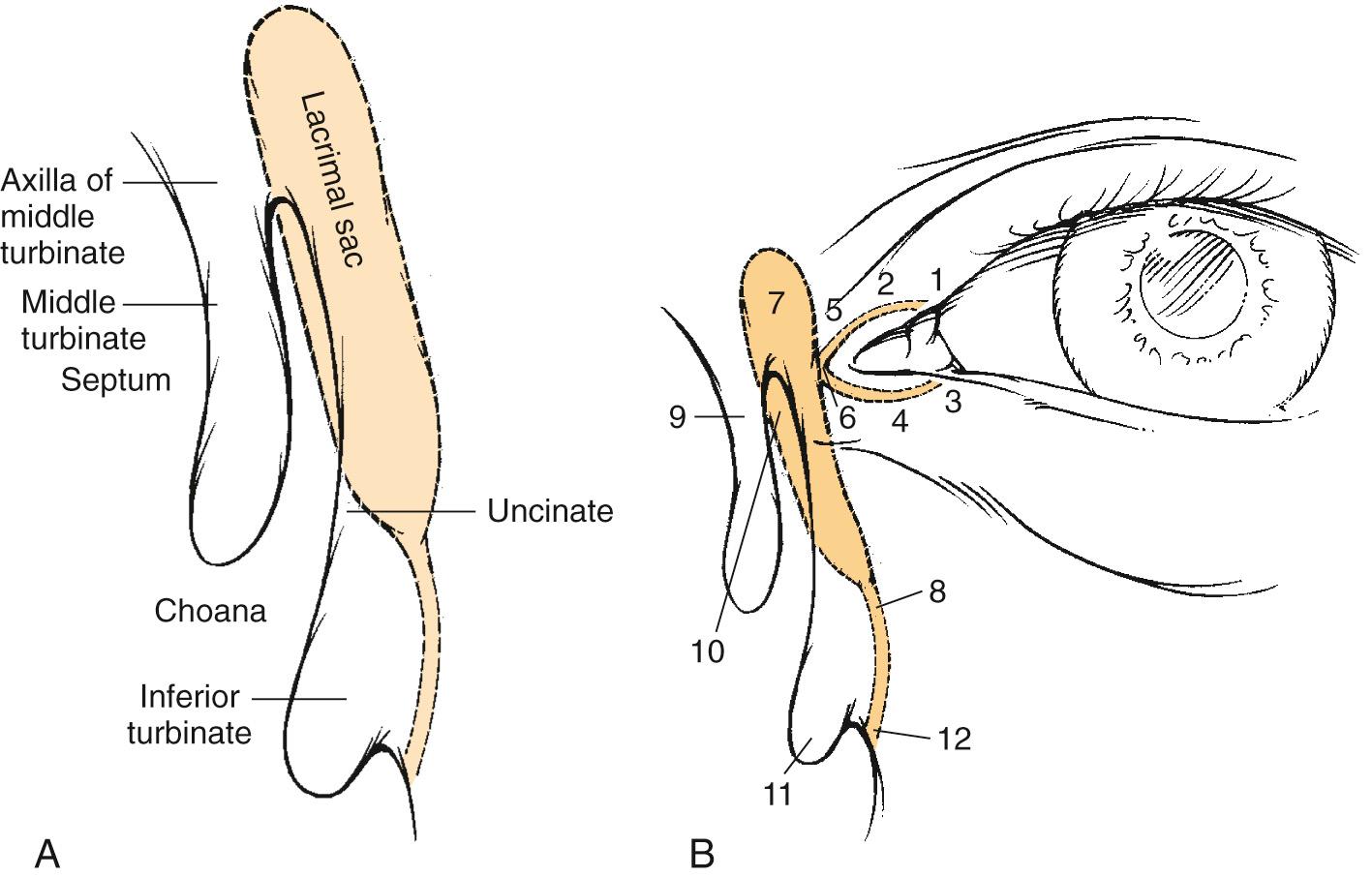
Two main components are included in the diagnostic evaluation of the patient who comes to medical attention with epiphora: physical and radiologic examinations. The physical examination begins by excluding lid laxity, malposition, punctal anomalies, and blepharitis. Palpation over the lacrimal sac is performed to search for reflux of mucopurulence as a result of dacryocystitis, which suggests an obstruction amenable to DCR. Next, the dye disappearance test is performed with a drop of 2% fluorescein into both conjunctival fornices. A normal test result shows complete symmetrical disappearance of dye within 5 minutes. A cotton swab placed in the inferior meatus is additionally used to confirm the flow of fluorescein (positive Jones I test). For abnormal test results, a more detailed investigation of the lacrimal system should be performed with the Jones II test as follows: a size 0 or 00 Bowman lacrimal probe is then placed along the inferior or superior canaliculus to palpate the common internal punctum (valve of Rosenmüller). A soft stop suggests impeded progress of the lacrimal probe prior to entering the lacrimal sac and requires further assessment; a hard-stop is felt when the distal end of the probe impacts the medial wall of the lacrimal sac/bone, which implies no stenosis of the canalicular system. Finally, a 25-gauge blunt lacrimal needle is placed into the inferior punctum to gently irrigate the lacrimal system with clear (nonflourescein dyed) saline. If the patient tastes saline, this rules out a complete obstruction but does not give information regarding a functional obstruction; an anatomic obstruction will lead to a reflux of saline, and the patient will not taste it.
The Jones I and II tests are used in conjunction to attempt to properly diagnose the site of obstruction. If the canalicular system and sac are open, but the duct is obstructed, fluorescein will accumulate within the sac during the Jones I test. As the puncta are irrigated with clear saline during the Jones II test, the clear irrigant will pick up fluorescein from the sac and will return yellow-stained saline. If the sac is not open, there is not enough fluorescein in the lacrimal system to stain the irrigant and the reflux will be clear. The Jones II test results allow for the following conclusions: (1) reflux of clear saline fluid from the same punctum being irrigated indicates obstruction proximal to the common canaliculus because fluorescein did not fill the lacrimal sac during Jones I and is not present in sufficient quantity to stain refluxing saline; (2) reflux of clear fluid from the opposite punctum indicates obstruction of the common canaliculus or common internal punctum; and (3) reflux of fluorescein-stained fluid through the opposite punctum indicates nasolacrimal duct obstruction (fluorescein present in lacrimal sac stains refluxing saline).
The radiologic evaluation for epiphora complements the Jones I and II tests. Scintilligraphy is the nuclear medicine equivalent of the dye disappearance test, but it is recorded over 30 minutes of study. Both functional and anatomic obstructions will be evident in this study ( Fig. 49.2 ). The second study, a dacryocystogram (DCG), requires syringing the lacrimal puncta with radiopaque dye. Again, three outcomes that correspond to the conclusions of the Jones II test, given above, can be determined. Evaluating the results of scintilligraphy and DCG together allows for the determination of functional obstructions (see Fig. 49.2A , [right] ) and anatomic obstructions ( Fig. 49.3 ; see also Fig. 49.2A , [left] ).
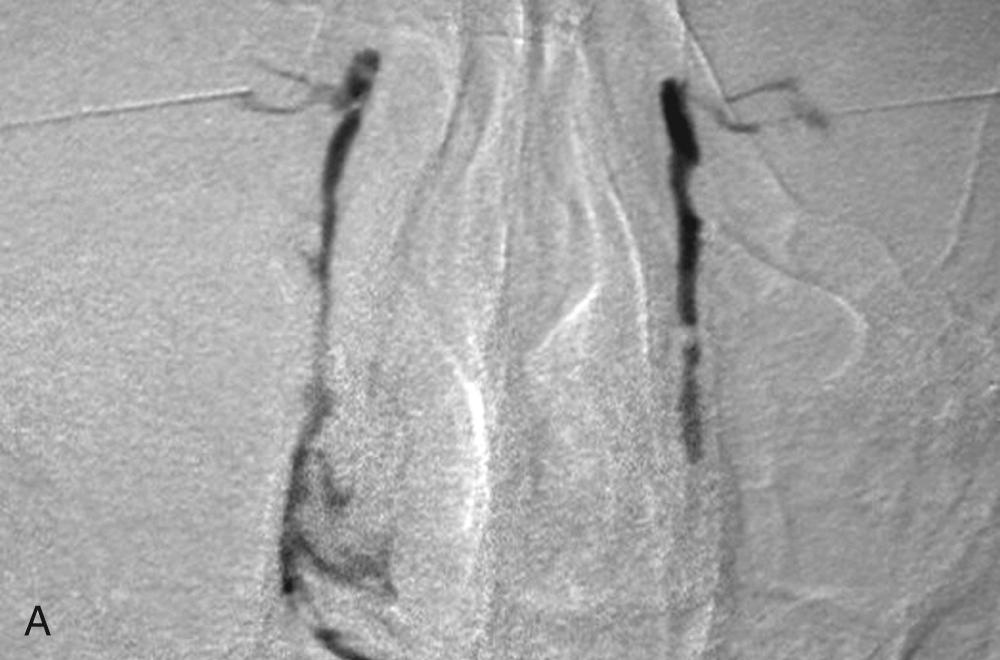
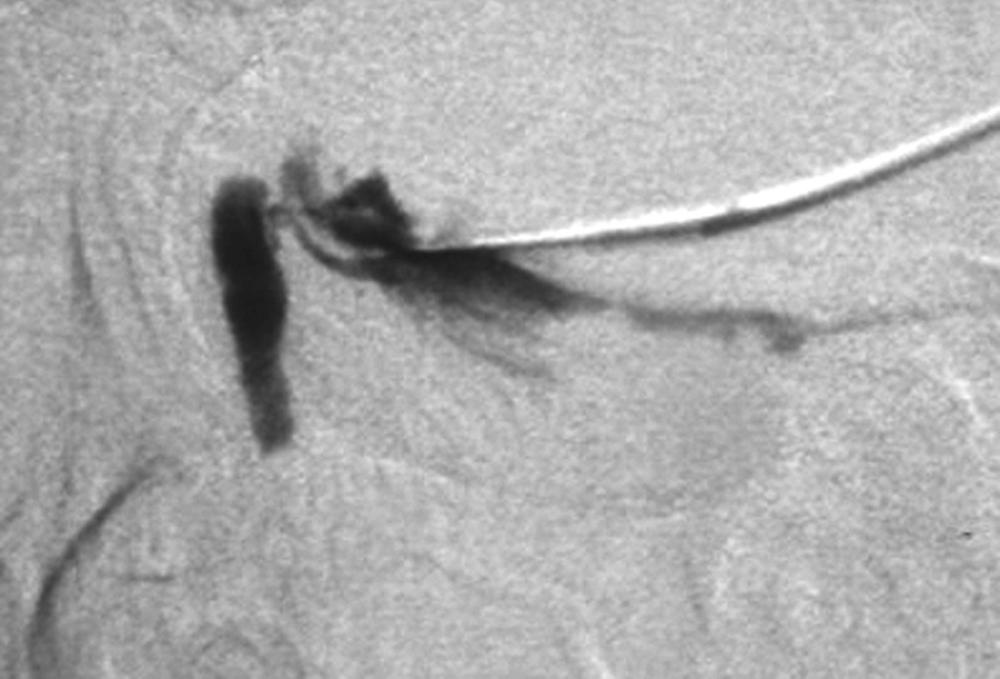
Because ergonomics are critical to the success of this procedure, the operating room must be optimized to improve endoscopic visualization. A few subtle maneuvers that are useful include creating head extension, allowing side-to-side mobility of the head, and placing the video monitor across from the surgeon. The surgical field must also be optimized at all times, because the apposition of mucosal flaps is critically important to the success of the procedure and requires completely dry fields to perform with certainty. Hemostasis is obtained with four major interventions: (1) working with the anesthetist to reduce cardiac output, (2) positioning the patient with the head raised about 30 degrees to reduce dependent vasocongestion, (3) injection of local anesthetic for vasoconstriction (1% lidocaine with 1 : 100,000 epinephrine), and (4) periodic placement of neuropatties containing 1 : 1000 epinephrine. Finally, a high endoscopic approach septoplasty ( Fig. 49.4 ) is performed in about 50% of endoscopic DCRs to create adequate potential space in the anterior-superior nasal cavity. Once completed, the remainder of the procedure is performed with a 30-degree scope aimed in a superolateral direction.
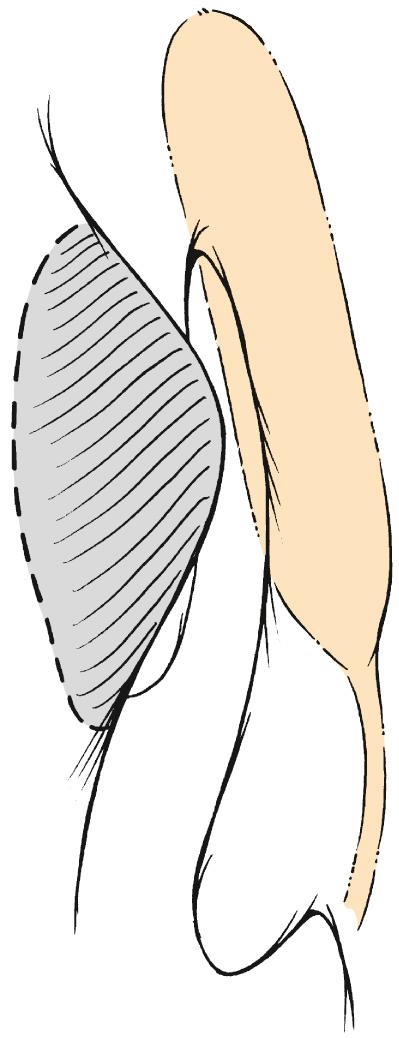
A posteriorly pedicled mucoperiosteal flap is elevated according to the dimensions shown in Fig. 49.5 , with a No. 15 blade for incisions and a sharp-suction Freer elevator to achieve the elevation. It is important to elevate the flap off the entire lacrimal bone so that it is attached inferiorly on the uncinate process and superiorly on the axilla of the middle turbinate ( Fig. 49.6 ). Hemostasis should be regained at this point with topical vasoconstrictors.
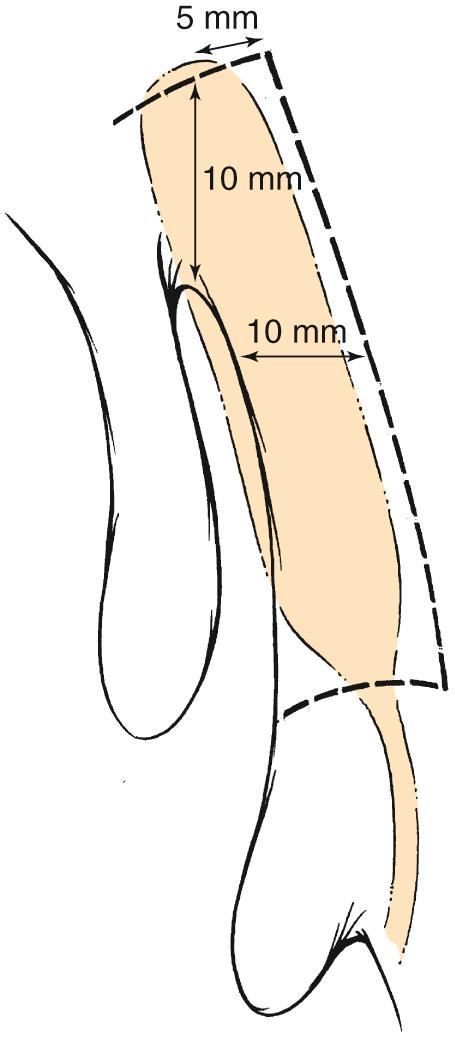
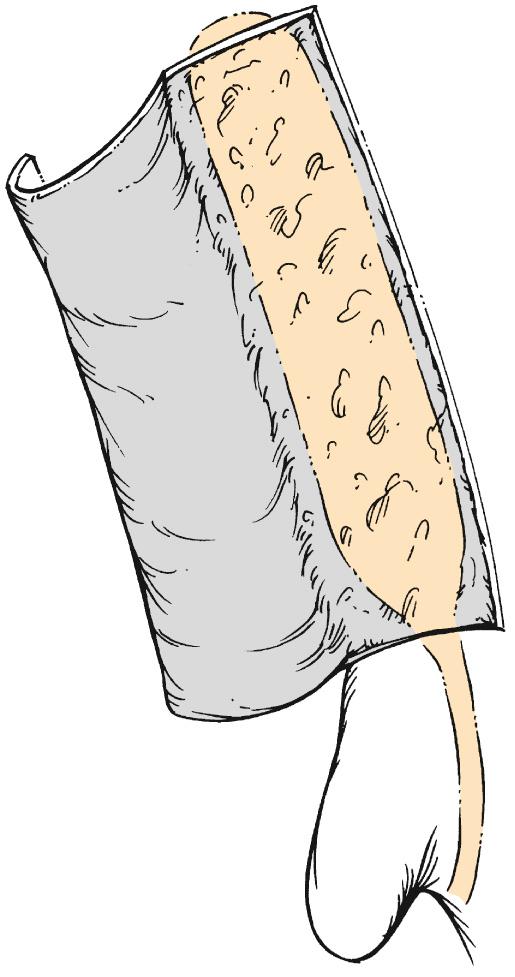
The frontal process of the maxilla covering the anterior portion of the lacrimal sac is now removed with a forward-biting rongeur, either a 4-mm Hajek-Koeffler punch or a 4-mm forward-biting Kerrison punch. The initial purchase is created by disarticulating the lacrimal bone laterally along the maxillolacrimal suture and biting through the exposed portion of the maxilla. Care must be taken to release the punch after biting the bone, because this maneuver releases any underlying soft tissue attachment (usually the sac wall), and failure to do this may result in damage to the sac when removing bone. Because it is normal to resect most of the axilla of the middle turbinate and the frontal process of the maxilla during this procedure, the agger nasi will usually be opened ( Fig. 49.7 ). When as much bone as possible is removed in this manner, the endoscopist will switch to a DCR drill bit to “saucerize” the remaining bone. Bone removal should be completed to the edges of the original nasal mucosal incisions to allow maximum exposure of the lacrimal sac. Drilling is complete when a hemisphere of the lacrimal sac sits “proud” on top of the saucerized frontal process of the maxilla. This will allow the marsupialized sac's flaps to lay open and not curl in on themselves during healing. Once drilling is complete, a round knife is used to flake off the lacrimal bone from the posterior portion of the lacrimal sac.
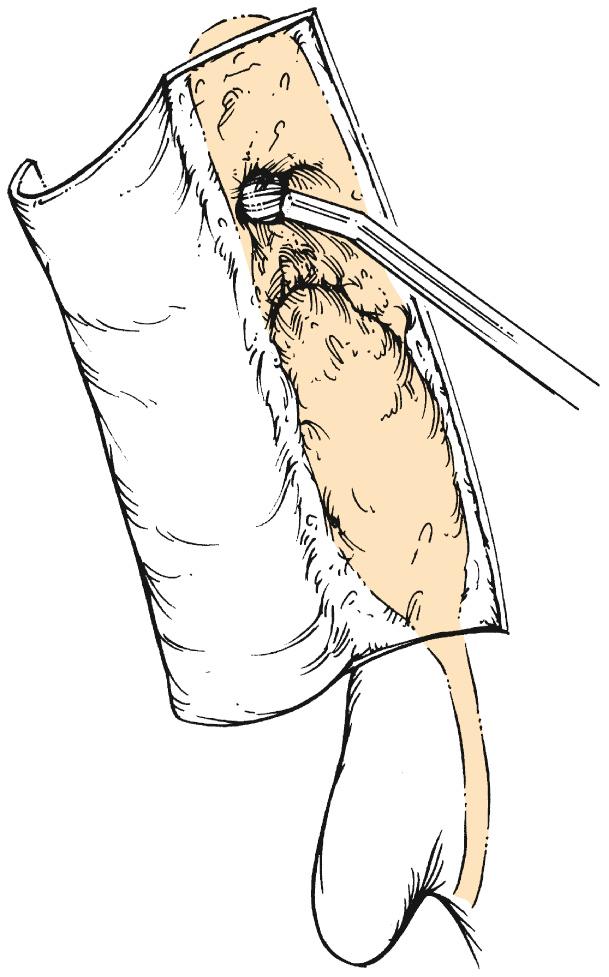
Attention is now directed to the superior and inferior lacrimal puncta, which should be dilated and then cannulated with Bowman probes. A 00 probe is usually placed through the inferior canaliculus, and the probe is directed initially horizontally and slightly posteriorly from the coronal plane but, as the sac is approached, the tip of the probe is directed superiorly through the common canaliculus and into the lacrimal sac. Before the sac is opened, it is vital to confirm that the probe is in the sac and not stuck in the common canaliculus. Cutting down onto the tip of the probe when it is still in the common canaliculus will damage the common canaliculus opening into the sac and may contribute to a poor outcome. To ensure that the probe is in the sac, the tip of the probe should be clearly visualized through the wall of the sac as it tents the wall medially. Unless the tip is clearly visualized, the sac should not be opened. When the probe is stuck in the common canaliculus, the whole sac moves with the probe, but the tip of the probe is not clearly seen.
Once the probe is evident in the lacrimal sac, a spear knife (Integra Life Sciences, New Jersey) is used to open the sac vertically from top to bottom. A ball probe can be placed through the medial sac wall incision to check the adequacy of bone removal at this time. To allow both anterior and posterior flaps to be laid open without tension, the posterior flap is released at its superior and inferior margins with Bellucci scissors and the anterior flap is released with a lacrimal mini-sickle knife (Integra Life Sciences, New Jersey). For surgeons unable to acquire this set, an alternative option utilizes a #12 blade or a Beaver 2.5 mm angled tympanoplasty blade (#377200) to create the vertical sac incision and the anterior flap. If adequate bone has been removed during the saucerization process, the flaps will fall into an open position and will remain there ( Fig. 49.8 ).
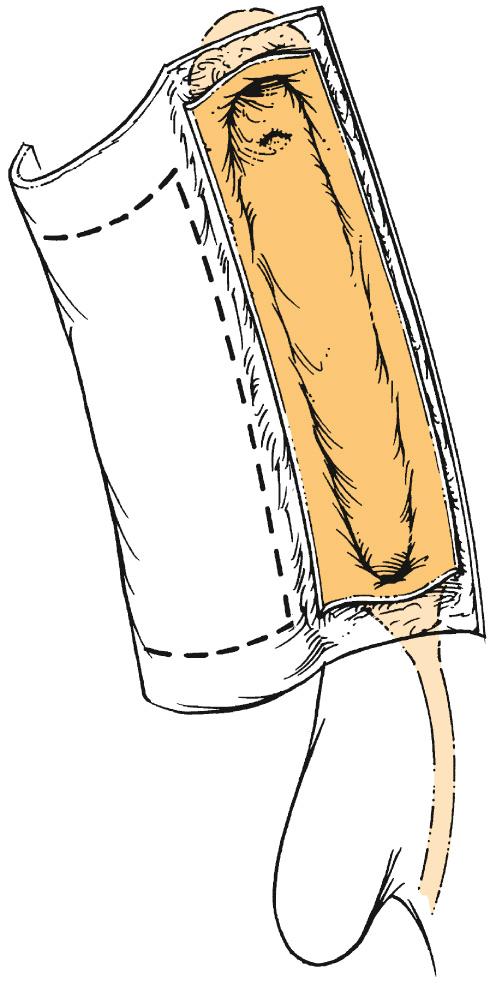
The lateral nasal wall flap elevated at the beginning of the case is now trimmed to accommodate the opened lacrimal sac (see Fig. 49.8 ). A square segment is removed from the anterior portion of the flap commensurate with the size of the opened sac; this is done using sharp pediatric through-cutting Blakesley forceps. A ball probe is used to manipulate all flaps into their final position. The decision as to whether to place lacrimal stents is now made. In general, we have a lower threshold to place stents in functional nasolacrimal obstruction, because one of the causes of intermittent obstruction is narrowing of the lacrimal system, especially the common canaliculus. The most important criterion on which the decision is made to stent or not to stent is the tightness of the common canaliculus. This is assessed by watching the Bowman probe move through the common canaliculus. If the probe is tightly gripped by the common canaliculus, stents are placed. However, if passage of the Bowman probe occurred without resistance through the canaliculi and the valve of Rosenmüller, tubes need not be placed. In the event of tightness of the common canaliculus, intubation with O'Donoghue probes (BD Visitec, Bidford-Upon-Avon, UK) or other such tubes should be performed. Care must be taken to secure tubes in a tension-free manner to prevent “cheese-wiring” through the delicate lacrimal puncta. To secure the tubes and keep the flaps in place, a 1.5-cm square of GelFoam is slid up the tubes, followed by a segment of 4-mm silicone tubing and two titanium Liga clips ( Fig. 49.9 ). Tubes should be left in place for a minimum of 4 to 6 weeks. If the patient was thought to have common canaliculus stenosis, the tubes can be left in for 6 to 9 months.
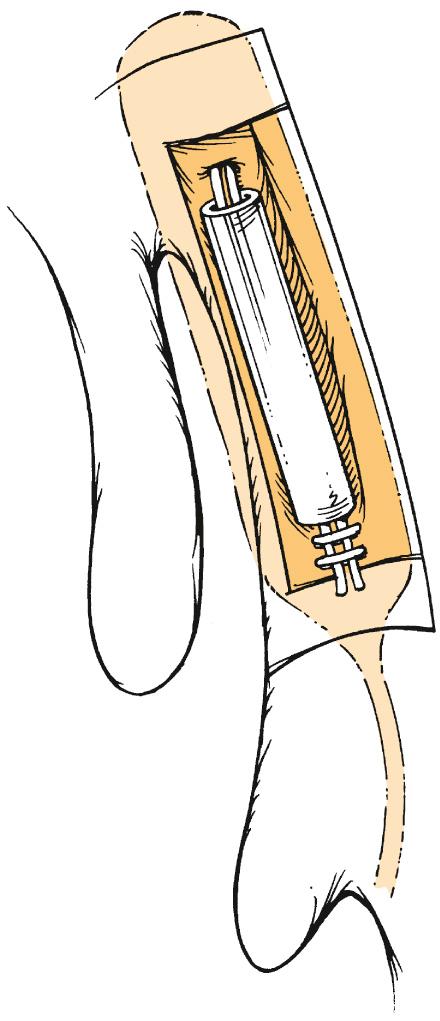
The initial steps in revision DCR are similar to the primary technique. It is important to ensure that the initial incisions into the nasal mucosa are made onto bone so that elevation of the mucosa off the bone gives the correct surgical plane. As this plane is developed up to the previous site of surgery on the sac, a scalpel is used to remove the scar tissue from the medial wall of the sac. Next, the bony ostium is revised to ensure complete sac exposure. At this point, the DCG should be reviewed to establish the size of the sac available for marsupialization. If surgical failure was due to an inadequately opened sac, ample mucosa will be available for marsupialization. Outcomes in this circumstance are expected to be similar to primary DCR. However, if the available sac is highly scarred or small, outcomes may be compromised because the amount of mucosa available for marsupialization is limited. Tailoring of the nasal mucosal flap to the available sac mucosa improves the outcome because it provides nasolacrimal mucosa apposition with limited need for granulation tissue healing.
For cases of anatomic obstruction, surgeons should achieve a 95% to 97% success rate, defined as the free flow of fluorescein into the nose and an asymptomatic patient, to be consistent with reported outcomes. Functional obstructions will likewise achieve a similar rate of technical success with lacrimal patency (clear flow of fluorescein); however, only 81% of functional patients will report complete relief of symptoms, a discrepancy related to the underlying pathophysiology of functional obstruction, whereby ongoing lacrimal pump anomalies cause continued collection of tears on the globe. However, those functional patients who do not meet the criteria for success (absence of symptoms) still enjoy an appreciable amount of improvement. An experience bias generally dictates which approach, endoscopic or external, has the optimal outcome in each surgeon's hands; however, numerous studies show that equivalent or better outcomes can be achieved by the endoscopic method. As approximately half of endoscopic cases will require additional nasal procedures, a surgeon considering endoscopic DCR should have established proficiency in all aspects of rhinology to expect to achieve reported outcomes.
Lacrimal duct and sac obstructions are most commonly treated by three procedures: external, endoscopic, and laser-assisted DCR. Outcomes with endoscopic procedures are highly dependent on how the sac is managed; thus, any discussion on endoscopic DCR must specify the extent of sac marsupialization. The two most commonly discussed variations on the endoscopic technique involve either complete preservation/marsupialization of the sac or medial lacrimal sac wall excision. Statistics reported in this chapter refer only to the complete preservation of mucosa with the marsupialization technique. Long-term stability of the endoscopic DCR ostium size with marsupialization has been proven in a series of 60 patients. After 4 weeks, no further change in size should be anticipated. Outcomes of external and endonasal DCR are currently considered largely similar in the hands of an expert oculoplastic surgeon. Laser-assisted DCR shows poor short-term and long-term results compared with the other two techniques ( Table 49.1 ). Unsuccessful options to be avoided include placement of a grommet through the medial sac wall or a vertical sac slit without marsupialization, both of which are associated with over 65% failure rates. Less commonly reported techniques include transcanalicular laser-assisted balloon dacryoplasty and conjunctivo-DCR.
| Procedure Type | Immediate | ∼5 Year |
|---|---|---|
| Endoscopic | 84%–94% | 92% |
| External | 65%–100% | 94% |
| Laser-assisted | 47%–100% | 38% |
Research now suggests that antimetabolites, including mitomycin C and 5-fluorouracil, do not improve results. However, a few controversial studies have reported better outcomes. Stenting the proximal lacrimal system with silicone tubing for 1 to 6 months has been a standard postoperative measure to encourage the system to heal in a patent configuration. However, reports suggest that tubing may be considered optional and has little added benefit to outcomes.
The size of the remaining lacrimal sac predicts outcomes to be expected with revision surgery. All patients who have undergone prior DCR, either external or endoscopic, should have a preoperative DCG to evaluate the size of the lacrimal sac. If the sac is of normal size, the success rate of the procedure is similar to that of a primary procedure. However, if scarring and cicatrization of the sac are present, the success rates drop; because even with full sac exposure, only a small amount of lacrimal mucosa can be marsupialized. However, overall outcomes of revision endoscopic DCR tend to still be quite good (91.3% anatomic patency with 87% functional success rates).
Become a Clinical Tree membership for Full access and enjoy Unlimited articles
If you are a member. Log in here